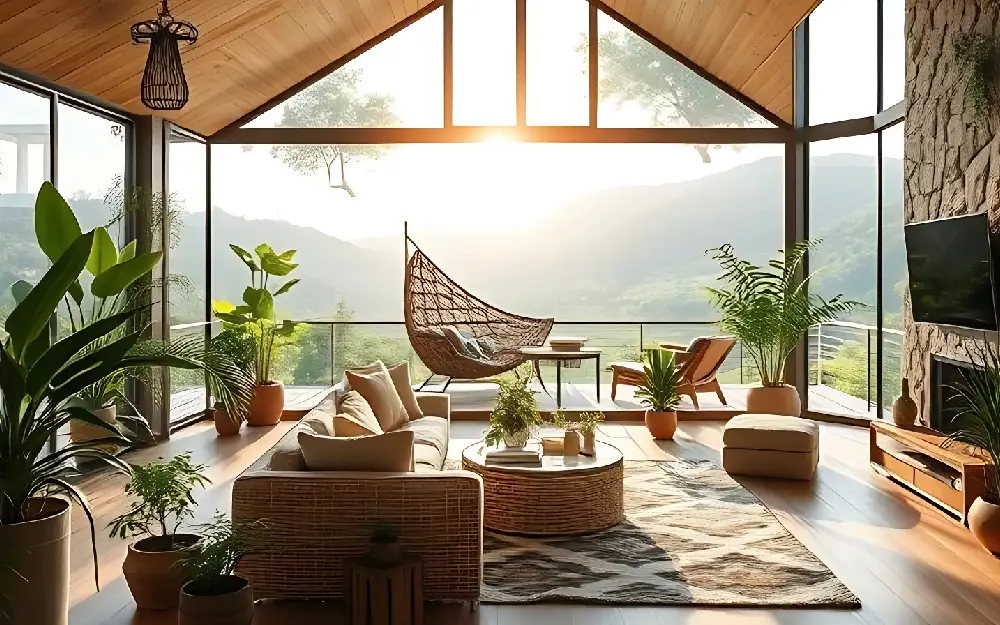In recent years, the concept of biophilic design has taken the world of architecture and home building by storm. This design approach, rooted in our innate connection to nature, focuses on incorporating natural elements into indoor environments to enhance our well-being. With an increasing number of people seeking to create more harmonious living spaces, biophilic design has proven to be an effective way to bring the outside in and transform our homes into calming sanctuaries.
What is Biophilic Design?
Biophilic design is the practice of incorporating natural elements, patterns, and forms into the built environment. The term “biophilia” comes from the Greek words “bios” (life) and “philia” (love), essentially meaning a love for life and living things. It acknowledges the deep, intrinsic bond humans have with nature and seeks to re-establish that connection in urban and indoor settings.
When applied to home building, biophilic design can include anything from using natural materials like wood and stone to creating spaces that maximize natural light and airflow, as well as bringing plants and greenery indoors. The goal is to create a space that not only looks beautiful but also nurtures the body and mind by promoting physical and mental well-being.
The Benefits of Biophilic Design
1. Improved Mental Health and Well-being
Studies have shown that access to nature—whether through outdoor experiences or nature-inspired indoor spaces—can significantly reduce stress, anxiety, and depression. When we are surrounded by nature, even in a controlled indoor setting, our bodies and minds tend to relax and recharge. Elements like indoor plants, natural lighting, and calming water features can all contribute to lowering blood pressure, improving mood, and increasing overall happiness.
2. Enhanced Productivity and Creativity
Biophilic design not only nurtures the mind but also boosts creativity and cognitive function. Many people have experienced the positive effects of working near windows or spending time in green spaces. Biophilic elements in home offices or study areas can enhance focus, problem-solving skills, and innovation. The connection to nature stimulates cognitive function, making it easier to think clearly and approach tasks with renewed energy.
3. Better Indoor Air Quality
Integrating plants into the home, a common biophilic design element, can help purify the air. Certain plants, such as spider plants, peace lilies, and snake plants, naturally absorb toxins and release oxygen. This helps improve the air quality inside the home, making it fresher and more conducive to good health.
4. Sustainability and Environmental Benefits
Biophilic design also emphasizes sustainability by encouraging the use of eco-friendly materials, energy-efficient solutions, and designs that work in harmony with the natural surroundings. By choosing sustainable building materials such as reclaimed wood, natural stone, and non-toxic paints, biophilic homes reduce their environmental impact while fostering a deeper respect for nature.
Key Elements of Biophilic Design in Home Building
1. Natural Light and Ventilation
One of the cornerstones of biophilic design is maximizing natural light. Large windows, skylights, and strategically placed openings allow sunlight to flood the interior, reducing the need for artificial lighting and improving the ambiance. Natural light has been shown to regulate circadian rhythms, improve sleep quality, and boost mood. Adequate ventilation is equally important, ensuring fresh air circulation and reducing the reliance on air conditioning and artificial cooling systems.
2. Indoor Plants and Greenery
Incorporating plants into your living space is one of the most effective and visually impactful ways to embrace biophilic design. From potted plants to living walls and indoor gardens, greenery helps create a vibrant, dynamic atmosphere that can transform any room. Plants not only purify the air but also contribute to a sense of calm and connection to the natural world.
3. Natural Materials
Biophilic design embraces the use of natural materials, such as wood, stone, bamboo, and cork, to create tactile surfaces and textures that mimic nature’s beauty. Wooden floors, stone countertops, and wicker furniture help to warm up a space and bring the outdoors in. These materials have an organic, timeless quality that helps create a soothing, grounding atmosphere.
4. Water Features
The soothing sound of water is another essential element of biophilic design. Incorporating water features, such as indoor fountains, ponds, or even a small waterfall, can add a sense of tranquility to your home. The calming sound of flowing water has been shown to reduce stress and create a peaceful environment.
5. Views and Connection to the Outdoors
Biophilic design also emphasizes the importance of creating a seamless connection between indoor and outdoor spaces. Large windows that offer expansive views of gardens, forests, or water can bring the outdoors into your home, even if you live in an urban environment. If possible, consider designing your space to open up to a garden or patio where you can spend time in nature, enhancing your overall connection to the environment.
Biophilic Design in Practice: Transforming Your Home
- Start small by adding a few indoor plants in your living areas. Choose plants that thrive in low light or air-purifying varieties.
- Use natural materials for furniture, flooring, and accents. Opt for reclaimed wood, stone tiles, or bamboo to bring the texture and warmth of nature indoors.
- Maximize natural light by installing large windows, skylights, or glass doors that open to outdoor spaces.
- Incorporate water features like tabletop fountains or an indoor pond to create a soothing, serene atmosphere.
- Design with views in mind: Arrange furniture to take full advantage of scenic views, and create outdoor spaces that feel like extensions of your indoor areas.
Conclusion
Incorporating biophilic design into your home isn’t just about aesthetic appeal—it’s about creating a space that nurtures your body and mind, helping you lead a healthier, more balanced life. By embracing the beauty and benefits of nature, biophilic design provides a way to reconnect with the world around us, no matter where we live. Whether you’re building a new home or redesigning your existing space, biophilic design can help you create an environment that is peaceful, inspiring, and, most importantly, connected to nature.

